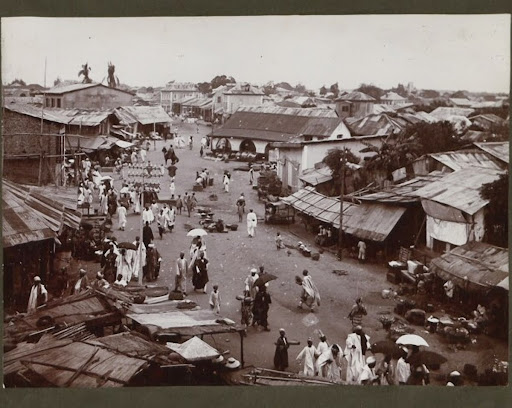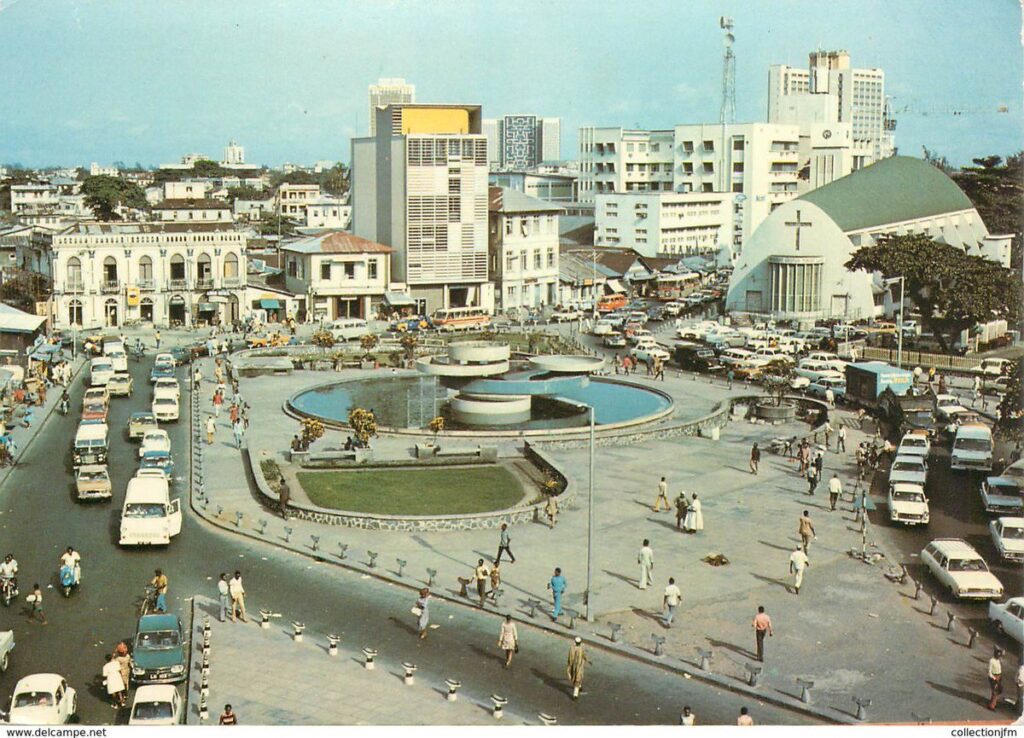Lagos is a state in southwestern Nigeria that is located on the coast of the Benin Bight. It is bordered on the north and east by the state of Ogun; on the south by the Benin Bight, and on the west by the Republic of Benin. The British administered the state’s territory as part of the Nigerian colony from 1914 until 1954. The Federal Territory of Lagos, which is the 27-square-mile (70-square-kilometre) territory of Lagos Island, including the city of Lagos, was established under the 1954 constitution, while the city’s hinterland was transferred to the Western Nigeria administrative division.
Lagos is also known as “Eko” in Yoruba. With a population of 15.3 million people in the city proper as of 2015, it is Nigeria’s largest city and Africa’s second most populous city. It served as Nigeria’s national capital until December 1991, when the government chose to relocate the country’s capital to Abuja, in the country’s centre. As of 2018, the Lagos metropolitan region had a population of around 23.5 million people, making it Africa’s largest metropolitan area. Lagos is a major African financial centre as well as the economic centre of Lagos State and Nigeria. The city has been dubbed Africa’s cultural, financial, and entertainment capital, and it has a major impact on commerce, entertainment, technology, education, politics, tourism, art, and fashion.
Lagos is also among the top ten fastest-growing cities and urban areas in the world. The megacity has Africa’s fourth-highest GDP and is home to one of the continent’s largest and busiest seaports. In Sub-Saharan Africa, the Lagos metropolitan region is a major educational and cultural centre.
With the influx of other Nigerians and West Africans to Lagos, the state’s predominantly Yoruba population has become more diverse. Cassava (manioc), palm oil and kernels, coconuts, corn (maize), vegetables, fruits, and fish are among the agricultural and fishing products produced in Lagos state. These goods are collected in the lagoon ports of Badagry, Epe, and Ikorodu, and then transported to markets in Lagos.

History
Lagos’ original name was Eko, which related mostly to the island until the Portuguese name “Lagos” was adopted. History has it that the Aworis arrived in Eko first in the 15th century, followed by the Binis in the 16th century. Later, the Empire of Benin conquered the Aworis. Meanwhile, the Awori hunters and fishermen had initially travelled to the seashore from Ile-Ife to dwell in Eko. The Awori relocated to Iddo Island, which is now part of Lagos Island. The Awori colony spread to Benin in the 16th century, and Benin became a war camp known as “Ile Ibinu” under the Oba of the time. Lagos is still referred to as Eko.
The settlement was given the name Lagos (Portuguese for “lakes”) by the Portuguese. It was home to a number of warring ethnic Yoruba clans who had established themselves in the area throughout history. The state first came to the attention of the Portuguese in the 15th century, following its early settlement by the Awori nobility. Rui de Sequeira, a Portuguese explorer, visited the area in 1472 and named the area around the city Lago de Curamo, which translates to “Lake of Curamo.”
The British West Africa Squadron, or Preventative Squadron, continued to pursue Portuguese, American, French, and Cuban slave ships and imposed anti-slavery treaties with West African coastal chiefs with such tenacity in the early nineteenth century that they established a strong presence along the West African coast from Sierra Leone all the way to the Niger Delta (today’s Nigeria) and as far south as Congo. Britain appointed John Beecroft Consul of the Bights of Benin, Biafra in 1849, a position he held until his death in 1854 (along with his governorship of Fernando Po).
Vice Consul John Duncan was assigned to the city of Wydah. The Kingdom of Lagos under Oba Kosoko was an important slave trade port in the western section of the Consulate of the Bights of Benin and Biafra at the time of Beecroft’s appointment. In 1851, Britain interfered in Lagos in what is now known as the Bombardment of Lagos or Capture of Lagos, in response to pressure from freed slaves who now wielded political and business power, resulting in the installation of Oba Akitoye and the expulsion of Oba Kosoko. The Treaty of London and Lagos, which abolished slavery, was then signed by Oba Akitoye. The ratification of the 1852 contract marked the beginning of the Consular Period in Lagos’ history, during which Britain supplied military protection to the city.
Following threats from Kosoko and the French stationed at Wydah, Lord Palmerston (British Prime Minister) made the decision in 1861 to “assume the formal Protectorate of Lagos as soon as possible.” On July 30, 1861, aboard HMS Prometheus, William McCoskry, the Acting Consul in Lagos, conducted a meeting with Oba Dosunmu when Britain’s objective was revealed and a response to the terms was sought by August 1861. Dosunmu disputed the provisions of the contract, but when Commander Bedingfield threatened to assault Lagos, Dosunmu caved in and signed the Lagos Treaty of Cession on August 6, 1861.

Lagos Colony
On March 5, 1862, Lagos was constituted as a colony. The rest of modern-day Nigeria was acquired in 1887, and Lagos became the capital of the Colony and Protectorate of Nigeria in 1914, and it remained so following the country’s independence from Britain in 1960. Returnee ex-slaves known as Creoles arrived in Lagos from Freetown, Sierra Leone, Brazil, and the West Indies, along with migrants from all over Nigeria and other West African countries. The Creoles helped modernize Lagos, and their expertise in Portuguese design can still be evident in the buildings on Lagos Island. Lagos has evolved into a melting pot of Africans and Europeans since the 19th century.
On the 6th of August 1861, Commander Beddingfield of HMS Prometheus, accompanied by the Acting British Consul, William McCoskry, conquered Lagos under threat of force. Despite the threat of violence against Lagos and its people, Oba Dosunmu of Lagos, which is spelt “Docemo” in British papers, fought the cession for 11 days before signing the Lagos Treaty of Cession. On March 5, 1862, Lagos was constituted as a colony. By 1872, Lagos had grown to become a cosmopolitan commerce hub with a population of over 60,000 people. Between 1890 and 1897, the colony acquired a protectorate over most of Yorubaland as a result of continuous warfare between mainland Yoruba states.
By 1886, railway links and telephone cables had been created between Lagos and London. In 1898, the city implemented electric street lighting. As a result of Nigeria’s economic boom in the 1960s and 1970s, Lagos witnessed significant growth.
In February 1906, the protectorate was included in the newly formed Southern Nigeria Protectorate, and Lagos was named the capital of the Protectorate of Nigeria in January 1914. Lagos has now expanded to become the largest metropolis in West Africa, with a metropolitan population of about 9,000,000 people as of 2011.
Prior to the establishment of Lagos State on May 27, 1967, Lagos, the country’s capital, was administered directly by the Federal Government as a Federal Territory through the Federal Ministry of Lagos Affairs, with the Lagos City Council (LCC) in charge of governance. Lagos was eventually taken, together with the towns of the then Western region (Ikeja, Agege, Mushin, Ikorodu, Epe, and Badagry). Lagos was divided into seven Local Government Areas (LGAs) in the present day, while the other towns today make up 13 LGAs in the state. Until 1976, when the state capital was moved to Ikeja, Lagos served as both the state and federal capital. During Nigeria’s military administration, Lagos suffered greatly. The Federal Government’s seat was also formally shifted to Abuja on December 12, 1991. Lagos, on the other hand, remains the country’s financial capital and has grown to become the country’s most populous conurbation.

Lagos in the Post-Colonial Era
The State Creation and Transitional Provisions Decree No. 14 of 1967, which rebuilt Nigeria into a federation of 12 states, established Lagos State on May 27, 1967. Prior to the issuing of this decree, the Federal Government administers Lagos City, the country’s capital, directly through the Federal Ministry of Lagos Affairs. However, the then-Western Region government oversaw Ikeja, Agege, Mushin, Ikorodu, Epe, Surulere, and Badagry. The metropolis of Lagos was taken along with several other municipalities to form the state of Lagos, which was officially acknowledged as a semi-autonomous administrative entity on April 11, 1968.
Until 1976, when the state capital was relocated to Ikeja, Lagos served as both the state and federal capital. On December 12, 1991, the Federal Government’s seat was formally shifted to Abuja following the full formation of the Federal Capital Territory. Despite this, Lagos remains the country’s financial capital and has grown to become the state’s and country’s most populous city.

Modern-Day Lagos
According to UN-Habitat, Lagos, Nigeria’s lagoon city, Africa’s top NEPAD city, and the world’s sixth megacity, is a growing global urban agglomeration that acquired megacity status in 1995 when its population skyrocketed to over 10 million people. Lagos’ population increased from 31st in the world in 1985 to 13.4 million in 2000, making it the world’s sixth megacity and Africa’s leading urban centre and a nexus of national, regional, and global socio-economic and political activity.
The Megacity region, which encompasses 17 of the state’s 20 local government and 37 local council development areas as well as four local government areas in Nigeria’s neighbouring Ogun State, is geographically disjointed [maze of islands/mainland], located on poor soil [wetlands], and overwhelmed by its growth [urbanization rate of 6%–8%].
Lagos State is divided into five administrative divisions with a total land area of 351,861 hectares: Ikeja, Badagry, Ikorodu, Lagos [Eko], and Epe. Administrative Divisions Edict No. 3 of April 1968 established the divisions in May 1968. According to Nigeria’s federal system and the desire to bring governance, development, and participatory democracy to the grassroots, the divisions are divided into 20 local governments and 37 local council development areas.





